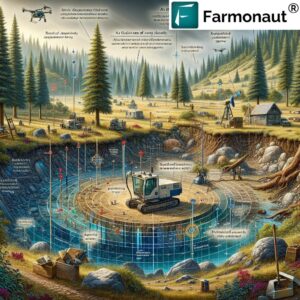
Santa Rosa County Farmland: 7 Powerful Steps for Rural Protection
Explore rural protection zone strategies, zoning for farmland protection, and sustainable land development amid urban pressures in Santa Rosa County.

Free Mulch New Jersey: 7 Powerful Ways to Boost Sustainable Gardens
Discover where to get free mulch in New Jersey! Local recycling centers offer soil, compost, and landscaping materials for sustainable

Community Garden Nutrition: 7 Inspiring StoryWalks in Machias
Explore community garden nutrition, outdoor reading for families, and healthy recipes for kids—discover seasonal activities for wellness and fun!

4 Sustainable Agriculture Strategies to Boost Costa Rica’s Competitiveness
Explore sustainable agriculture in Costa Rica—learn how innovative programs boost small producers, climate resilience, and access to international markets.

Vermont Farms: 7 Inspiring Stories of Sustainable Community Life
Explore farm life in Vermont as a vibrant farming community faces farm retirement, land challenges, and sustainable practices in northern

7 Key Tips to Follow Brevard County Fertilizer Ordinance for Lagoon Care
Discover Brevard County fertilizer ordinance, rain impacts, shoreline restrictions, and landscaping tips to protect the Indian River Lagoon from pollutants.

OTR Tires Market US 2025: Powerful Tariffs & Growth Trends
Explore 2025 global OTR tires market growth, US tariffs impact, demand in mining, tractors, construction, and key trends shaping the

Illinois Cover Crops: 7 Powerful Ways to Reduce Dust Storms
Discover how Illinois cover crops, conservation tillage, and crop residue management reduce dust storms, improve soil health, and boost farm

Farmworker Housing New York: 7 Urgent Issues Impacting Immigrants
Farmworker housing in New York faces critical challenges; learn about conditions, protections, and advocacy for undocumented farmworkers in the dairy

Importing Flowers from Mexico: 7 Vital CBP Rules to Protect Crops
Learn about importing flowers from Mexico, U.S. border restrictions, invasive species prevention, and how inspections protect crops and the environment.

Virginia Soybean Exports: 5 Powerful Impacts of China Tariffs
Explore how Virginia soybean exports and tariffs on China impact farmers, agricultural trade, and local economies. Uncover key market trends

International University Campuses in Mumbai: 7 Top Study Options
Discover global education opportunities as international university campuses in India expand, offering top STEM, business, and arts programs in Mumbai.

Canada vs Massachusetts Real Estate: 7 Key Investment Finance Insights
Explore real estate investment Canada, asset management Boston, and infrastructure finance Massachusetts for key insights on investment strategies. Read more!

Bornean Elephant Conservation: 5 Powerful Ways Sabah Protects Wildlife
Explore conservation and elephant friendly farming in Sabah; discover how sustainable practices protect endangered elephants and wildlife habitat amid palm

Sussex Beach Water Quality 2024: Shocking Brown Flag Winners Revealed
Discover 2024 Sussex beach water quality, Brown Flag Awards, and England beach cleanliness league table. Learn which UK coastlines are

7 Ways Vermont Schools Improve Student Nutrition
Discover how Vermont’s school nutrition program provides free meals and nutrition education, boosting student food security and healthy school meals

Britain India Trade Deal: 5 Key ISDS Changes Impacting Investment
Britain India trade deal talks highlight the ISDS mechanism, tariffs, and investment treaty—discover policy changes impacting companies and future agreements.

5 Ways Glasgow Farm to School Funding Cuts Harm Local Farms
Discover how federal cuts impact farm to school programs, local agriculture in schools, and the vital support for family farms

Southampton Fiscal 2026 Budget: Key School Override & Tax Impact
Explore the fiscal 2026 town meeting warrant, school budget override, rising municipal insurance costs, and key appropriations impacting property taxes.

Wimbledon Rural Fire: 3 Semis Destroyed at Arrowwood Prairie Facility
Wimbledon rural fire department battled a fertilizer facility fire at Arrowwood Prairie; multiple trucks burned in parking lot. Read more

Irrigation in Saskatchewan: Unleashing Lake Diefenbaker’s $5.9
Discover how irrigation in Saskatchewan, Lake Diefenbaker water supply, and Westside projects boost economic impact, jobs, and climate resiliency.

Toronto Annual Financial Filings: 5 Key Compliance Trends for 2025
Explore annual financial statements, management filings, and new biotechnologies for remediation and reclamation under Canadian securities regulations.

Canadian Rail Industry Trends: 7 Powerful Insights on Cargo & Trade
Explore Canadian rail industry trends as Canada cargo shipments, petroleum transportation, and grain and fertilizer transport face shifting tariffs.

Bathymetrische Vermessungen: Präzise Drohnen-Kartierung für Vancouver
Bathymetrische Vermessungen und drohnenbasierte Inspektionen mit hoher Genauigkeit: Erfahren Sie mehr über innovative aquatische Kartierungslösungen.

7 Proven Cochrane Community Development Strategies for Northern Ontario
Explore community development in northern Ontario, council projects, housing, and infrastructure challenges facing remote communities and families in the region.

Porphyry Copper Gold Project: 3 Powerful Nevada Exploration Zones
Porphyry copper gold project in Nevada: soil survey, drill permit approval, hydrothermal mapping, rock sampling, and new mineral exploration insights.

Drones con inteligencia artificial: 7 soluciones innovadoras DaaS
Descubre cómo los drones con inteligencia artificial y DaaS revolucionan levantamientos batimétricos, gestión de riesgos y aplicaciones industriales.

Gold Soil Anomalies Unveiled: 2024 Drilling Boost in British Columbia
Discover the latest soil geochemistry trends, gold soil anomalies, and 2024 drilling program insights shaping gold exploration in British Columbia’s

5 Key Insights from Transvaal Mineral Exploration in South Africa
Explore the latest in mineral exploration south Africa, Transvaal supergroup mineralization, and soil sampling for minerals—discover new mining targets and

Gold Exploration Ontario: 5 Powerful Updates on Yellow Fox Targets
Explore gold exploration in Ontario, targeted soil sampling, and new mineral claims expansion. Discover trends and results in silver and

Charlottetown Affordable Housing: 5 Farmland Protection Insights
Explore affordable housing Charlottetown, rural development, and protecting farmland in Prince Edward Island amid residential sprawl concerns. Read more.

CubicFarms 2025 Financial Results: Key Vancouver Compliance Update
CubicFarms shares 2025 financial results and filing update, highlights automated vertical pastures technology and compliance with BC securities regulators.

Polisario-Maroc : 5 faits marquants sur la diplomatie au Sahara
Polisario, Maroc, et Sahara: actualités sur la rencontre Algérie-Polisario, incidents MINURSO, futsal féminin marocain, sécurité régionale, météo, salaires.

Minimum Wage Implementation in Abia: 5 Key Labour Demands for 2025
Explore minimum wage implementation, salary arrears payment, and worker welfare in Abia. Learn about labour union demands and ongoing economic

Non-oil Exports in Nigeria: 4,600+ Hybrid Seedlings Boost Farmers
Discover the latest on non-oil exports in Nigeria, hybrid seedlings distribution, export opportunities for farmers, and trends in agricultural value

معرض زهور الربيع القاهرة 2024: اكتشف النباتات النادرة وروعة الأ
معرض زهور الربيع القاهرة في المتحف الزراعي يضم نباتات الزينة والصبارات وأشجار نادرة بتنظيم مميز، اكتشف فعاليات الزراعة والألوان الطبيعية.

Irrigation Farming in Malawi: 9,800 Hectares Boost Food Security
Discover how irrigation farming in Malawi boosts crop production, supports farmers with loans and inputs, and enhances year-round food security.

Ponzi Schemes in Nigeria: 7 Red Flags to Avoid Costly Losses
Ponzi schemes in Nigeria are rising, with high-return digital investment fraud targeting investors in crypto, real estate, and agriculture. Learn

Precio del cacao en Costa de Marfil: impacto arancelario y retos 2024
El mercado global del cacao enfrenta alzas de precios en Costa de Marfil por aranceles, clima y desafíos en cultivos;

تعدين الفوسفات في مصر: 5 فرص قوية للاستثمار والنمو 2025
فرص واعدة في تعدين الفوسفات بمصر تعزز الاستثمار في الأسمدة الفوسفاتية وصناعة القيمة المضافة، مع تعاون هندي واكتشافات جديدة بالصحراء.

Morocco Minimum Wage Increase 2024: Historic Boost for Workers
Morocco minimum wage increase: Discover how government reforms boost agricultural workers’ wages, private sector inclusion, and pension benefits in 2024.

Food Security in Canada: 5 Powerful Steps for a Resilient Supply
Discover how food security in Canada is shaped by resilient agricultural policy, government action, and sustainable fruit and vegetable sector

5 Urgent Reasons to Protect Oro-Medonte Farmland from Barrie Industry
Barrie industrial development and land annexation threaten protected farmland, sparking strong community opposition and urgent calls for rural area protection.

Monterey County Downtown Grand Opening: 7 Must-See Events
Discover city news in Monterey County—grand openings, downtown events, library activities, agriculture, and traffic safety updates within city limits.

Atlanta Gold Mine Project: 25 Powerful New Drill Results Revealed
Discover the latest drilling results on silver mineralization in Nevada, shallow oxidized gold zones, and new exploration targets at the

5 Key Soil Survey Insights for Rare Earth Exploration in Manitoba
Explore rare earth element exploration in Canada with advanced soil sampling, geochemical analysis, and metagenomic sequencing trends in Manitoba and

Ontario Farm Plastic Recycling: 2.2 Million Kg Recycled This Earth Day
Discover how Canadian farmers lead sustainable farming through agricultural recycling programs, responsible farm waste management, and a circular economy.

7 Impactful School Garden Programs for Agriculture Education in Manitoba
Discover how classroom garden initiatives boost agriculture education, food literacy, and inspire careers in farming for students across Manitoba’s rural

Gold Exploration Breakthrough: 5 Key Sampling Results in Kainantu
Discover the latest in gold exploration projects, soil sampling and analysis, and geochemical indicators driving advanced drill target identification. Read

Arlington Soil Survey: 5 Key Insights from BC Gold Drilling
Explore the latest in Arlington soil survey and British Columbia gold drilling trends, including geophysical anomaly mapping and surface sampling